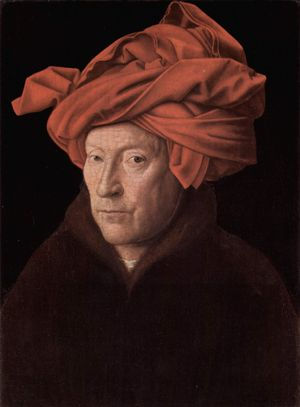(Maaseik 1390 - Bruges 1441)
The painter Jan van Eyck was the founder of the earliest Flemish School and he was born in Maaseik, which was a small city by the river Meuse and that was close to Maastricht.
From 1422 to 1424 he worked as painter and chamber assistant in the court of John of Bavaria at The Hague. After the death of the prince, he worked at the service of the Duke Philip the Good of Burgundy, who pointed van Eyck painter of the court and waiter earning 100 pounds a year. At the service of Philip the Good, he realized several diplomatic journeys in 1426, 1428-1429, and in 1436.
In 1428 he travelled with the embassy of Burgundy to Portugal in order to carry out the marriage of Philip to the princess Isabella of Portugal, whose portrait was painted by van Eyck and was sent to Burgundy. During this journey, he knew the southern vegetation that so often appears in his paintings. He died in Bruges the 9th of July, 1441.
His brother Hubert van Eyck was also a famous painter. Very few things of his life are known; the only thing which is known for sure is that in 1421-22 he joined the brotherhood of Our Lady of Sorrows in Ghent. Jodoco Wydt, who was a very rich man from Ghent, commissioned him the big altarpiece The Adoration of the Mystic Lamb, which was left unfinished because of Wydt’s death in September the 18th, 1426. Wydt was buried in the crypt of Saint Bavo (Ghent).
Many critics consider the appearance of these two masters as a phenomenon of spontaneous generation; however, the emergence of these two geniuses, although it seemed a sudden thing, was the result of a previous evolution.
In order to deal thoroughly with the problem regarding the age of the two brothers, it is necessary to know the famous work that strengthened their glory: the altarpiece in the church of St. Bavo in Guent. This polyptych, which is the biggest preserved representation of a Christian idea, would be enough to establish the reputation of the van Eyck brothers even if the rest of their works had disappeared.
Their way of painting clothes is the clearest sign to differentiate their paintings. Hubert always painted them with paste whereas in Jan’s artworks the clothes were performed with glazing. According to these characteristics, the triptych of Dresden must be attributed to Hubert, and The Madonna with Canon van der Paele must be attributed to Jan van Eyck.
In the Museum of Madrid there is a canvas named The Triumph of the church over the Synagogue that some people have attributed it to Hubert and some others have attributed it to Jan.
Some works by Jan van Eyck are preserved, and several of them are signed such as Madonna and Child, The Arnolfini Portrait, Portrait of Jan de Leeuw and The Madonna with Canon van der Paele among others.


